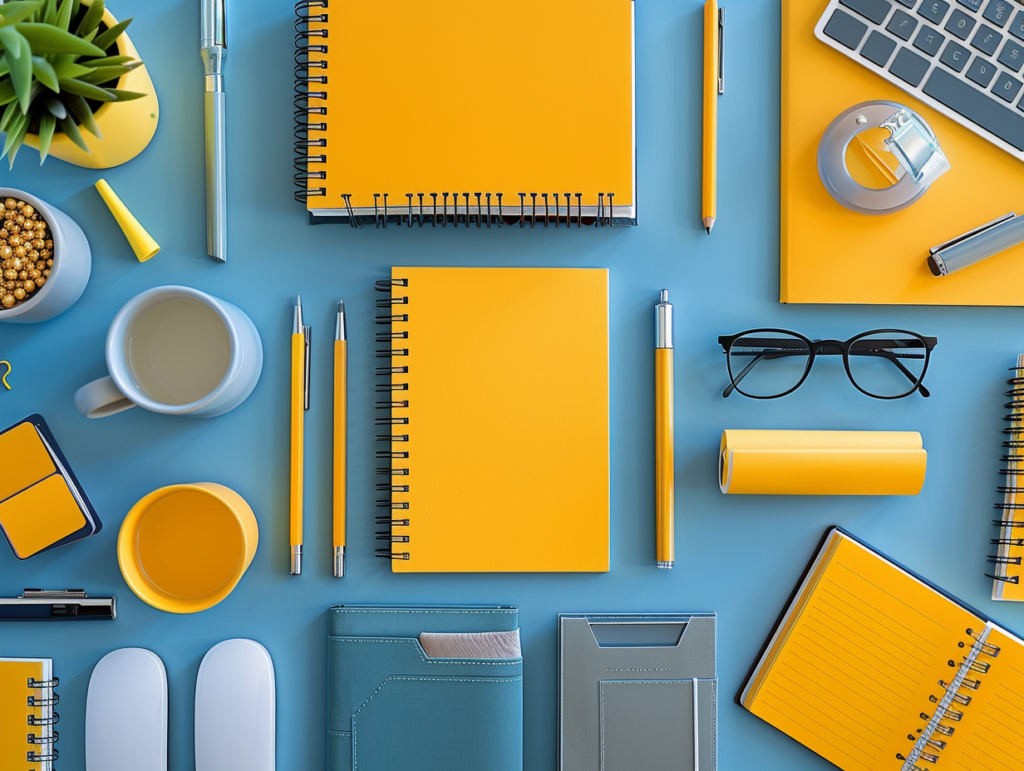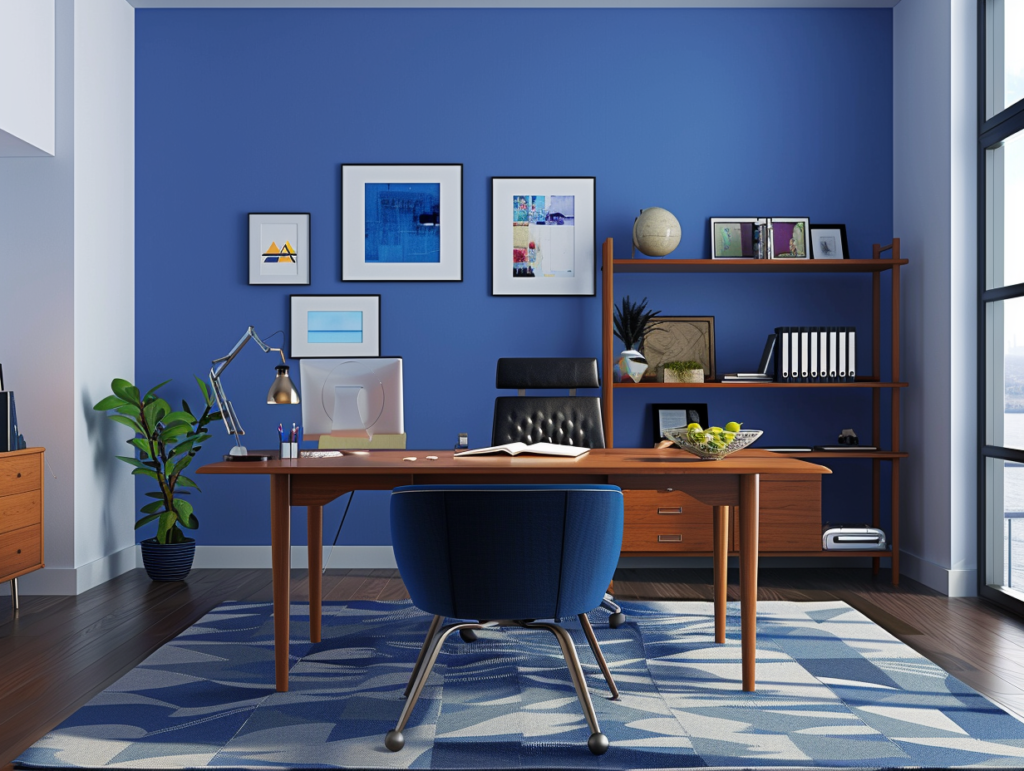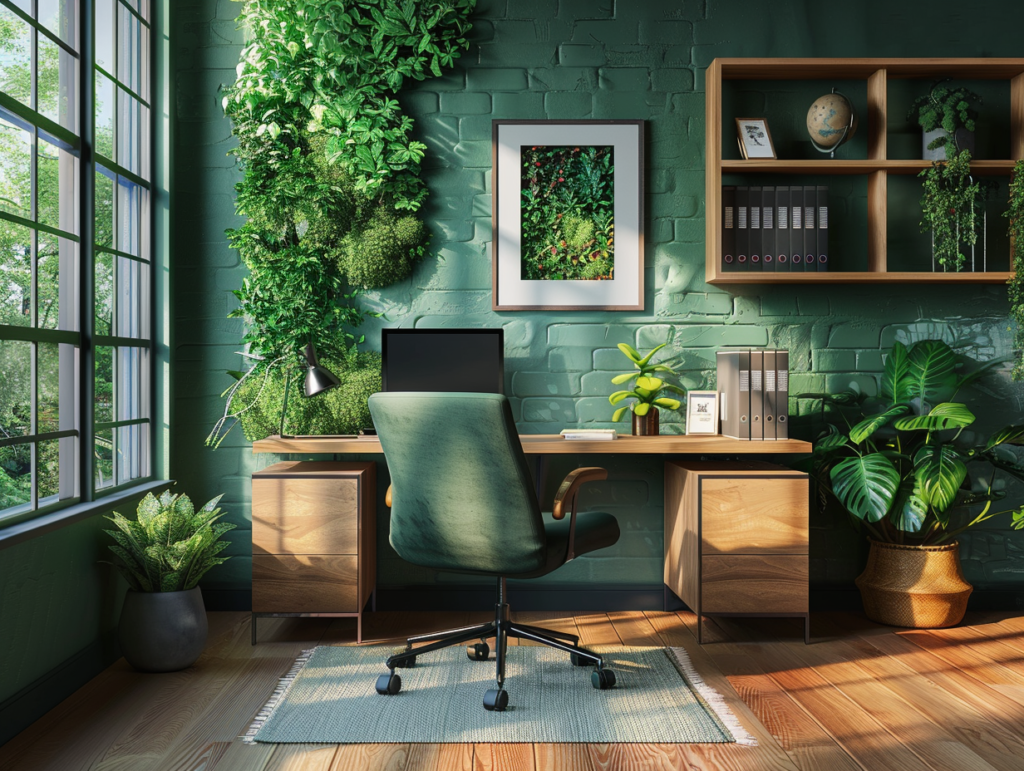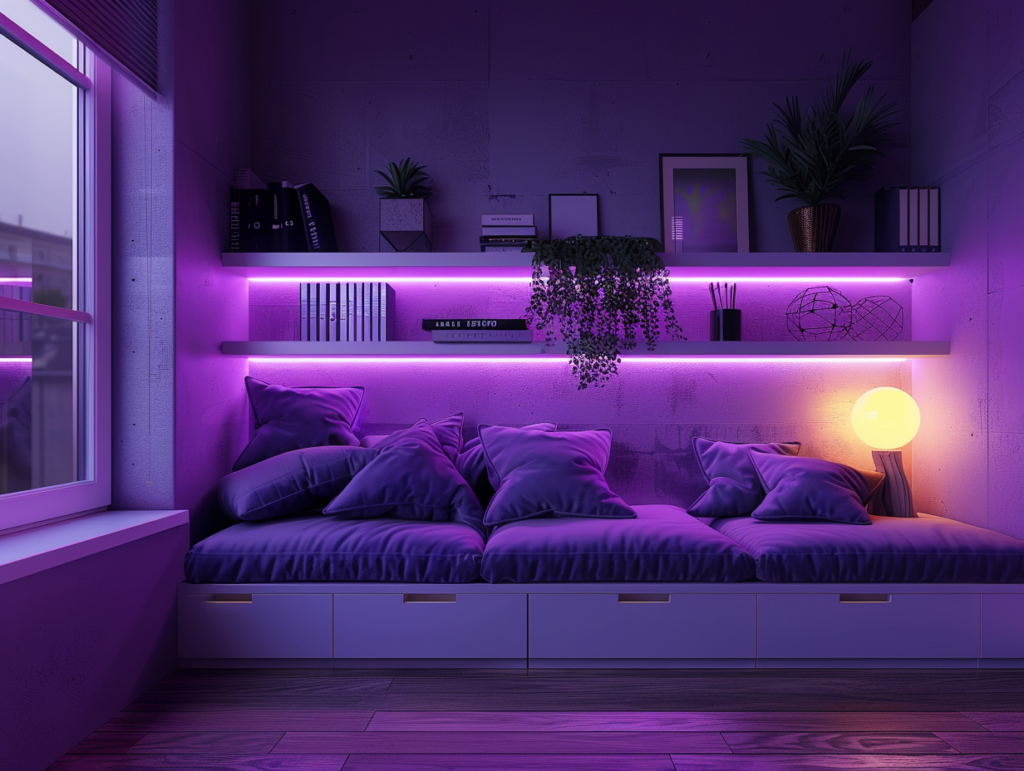
Table of Contents:
- Introduction to Color Psychology
- Understanding Color Psychology
- Colors and Productivity
- Applying Color Psychology in the Home Office
- Designing a Productive Workspace
- Overcoming Challenges
If you’ve ever felt like the color of your workspace was affecting your mood or productivity, you’re not alone. Many people believe that color can have a significant impact on our emotions and energy levels, and this is the basis of color psychology. By understanding how different colors can affect our mood and productivity, we can create a workspace that is both stimulating and productive.
In this article, we’ll explore the concept of color psychology and its impact on productivity in the workplace. We’ll discuss how different colors can affect mood, energy levels, and focus, particularly in a home office setting. We’ll also highlight practical tips for incorporating specific colors into the workspace to enhance productivity and creativity and address the challenge of creating a stimulating yet not overwhelming environment that fosters productivity.
At the end of this article, you’ll have a better understanding of how color psychology can impact your productivity and creativity, and you’ll have some practical tips for incorporating color into your workspace to create a productive and stimulating environment. So let’s get started!
Key Takeaways
- Understanding color psychology can help us create a productive and stimulating workspace.
- Different colors can affect our mood, energy levels, and focus in different ways.
- By incorporating specific colors into our workspace, we can enhance productivity and creativity.
Understanding Color Psychology

Color psychology is the study of how colors affect human behavior, emotions, and mood. It is an important aspect of interior design and can be used to create a specific atmosphere or mood in a space. In the workplace, color psychology can be used to create an environment that promotes productivity, creativity, and focus.
The Basics of Color Psychology
The basic principles of color psychology are based on the idea that different colors can evoke different emotional responses in people. For example, warm colors like red, orange, and yellow are often associated with energy, excitement, and passion, while cool colors like blue, green, and purple are often associated with calmness, relaxation, and tranquility.
Color’s Influence on Mood and Behavior

The colors in our environment can have a significant impact on our mood and behavior. For example, studies have shown that blue can help to increase focus and productivity, while yellow can help to stimulate creativity and innovation. Green is often associated with balance and harmony, making it a great choice for creating a calm and relaxing environment.
It is important to note that the impact of color on mood and behavior can vary from person to person, and cultural differences can also play a role. Therefore, it is important to consider the specific needs and preferences of individuals when incorporating color psychology into the workplace.
Overall, understanding color psychology can be a powerful tool for creating a workspace that promotes productivity, creativity, and focus. By carefully selecting colors that evoke the desired emotional response, and considering the needs and preferences of individuals, we can create a stimulating yet not overwhelming environment that fosters productivity.
Helpful Tip: Before making any changes,
observe the current colors in your workspace
and note how they make you feel throughout the day.
Colors and Productivity

When it comes to productivity, the colors in our workspace can have a significant impact on our mood, energy levels, and focus. By choosing the right colors for our home office, we can create an environment that fosters productivity and creativity. Here are some colors and how they can affect our productivity:
Red for Energy and Attention
Red is a color that can increase our heart rate and blood pressure, making us feel more energized and alert. It can also increase our attention to detail, making it a great color for tasks that require focus and accuracy. However, too much red can be overwhelming and cause stress, so it’s important to use it in moderation.
Blue for Calm and Focus
Blue is a calming color that can help us feel more relaxed and focused. It can also improve our ability to communicate and collaborate with others, making it a great color for team projects. However, too much blue can make us feel cold or detached, so it’s important to balance it with warmer colors.
Yellow for Creativity and Optimism
Yellow is a color that can boost our creativity and optimism, making it a great color for brainstorming sessions and creative projects. It can also increase our energy levels and help us stay motivated. However, too much yellow can be overstimulating and cause anxiety, so it’s important to use it in moderation.
Green for Balance and Calm
Green is a color that can create a sense of balance and calm, making it a great color for reducing stress and anxiety. It can also improve our ability to concentrate and make decisions, making it a great color for work that requires problem-solving. However, too much green can make us feel stagnant or unproductive, so it’s important to balance it with other colors.
By incorporating these colors into our home office, we can create a stimulating yet not overwhelming environment that fosters productivity. For example, we can use blue for the walls or furniture, red for accent pieces or accessories, yellow for artwork or decor, and green for plants or natural elements. By using these colors strategically, we can enhance our productivity and creativity in the workplace.
Helpful Tip: Consider the psychological effects of colors in context;
what works in one culture or setting might not apply universally.
Applying Color Psychology in the Home Office

When designing a home office, color psychology is an important aspect to consider. The right colors can have a significant impact on our mood, energy levels, and focus, ultimately affecting our productivity. Here are some practical tips for incorporating color psychology into your home office.
Choosing the Right Colors
Different colors have different effects on our mood and energy levels. For example, blue is known for its calming effect, making it a great choice for those who need to focus for long periods of time. Green is another calming color that can also promote creativity. Yellow is a great color for boosting energy levels and promoting positivity, but it should be used sparingly as it can also be overwhelming.
It’s important to choose colors that resonate with you personally, as well as colors that align with the type of work you do. For example, if you work in a creative field, you may want to incorporate more vibrant colors to stimulate your imagination.
Strategic Placement of Colors
Once you’ve chosen your colors, it’s important to strategically place them in your home office. Consider using your chosen colors for accent pieces such as artwork, plants, or desk accessories. This can help to create a stimulating environment without overwhelming your senses.
Another way to incorporate color is through the use of a feature wall. Choose one wall in your office to paint in a bold color or use wallpaper to add texture and interest. This can help to create a focal point in the room and draw your eye towards it.
Lighting and Color Intensity
When choosing colors for your home office, it’s important to consider the lighting in the room. Natural light can enhance the colors in your space, while artificial light can alter the way colors appear. Be sure to test your chosen colors in different lighting conditions to ensure they still have the desired effect.
It’s also important to consider the intensity of your chosen colors. Bright, bold colors can be stimulating, but they can also be overwhelming if used in excess. Consider using more muted tones for larger surfaces such as walls, and save brighter colors for accent pieces.
By incorporating color psychology into your home office design, you can create a space that fosters productivity and creativity. Remember to choose colors that resonate with you personally, strategically place your colors, and consider lighting and color intensity.
Helpful Tip: Use color accents strategically;
even a small pop of color like a red notebook
or a yellow mug can have a substantial
impact on your mood and productivity.
Designing a Productive Workspace

Designing a productive workspace is essential to boost productivity and creativity. Here are a few tips on how to create a workspace that fosters productivity and creativity.
Color Schemes for Productivity
Colors can have a significant impact on our mood, energy levels, and focus. Choosing the right color scheme for your workspace can help create a stimulating yet not overwhelming environment that fosters productivity.
- Blue: Blue is a calming color that promotes focus and concentration. It is an excellent choice for tasks that require attention to detail, such as data analysis or proofreading.
- Green: Green is a refreshing color that promotes balance and harmony. It is an excellent choice for creative tasks, such as brainstorming or ideation.
- Yellow: Yellow is a cheerful color that promotes optimism and creativity. It is an excellent choice for tasks that require a high level of creativity, such as graphic design or content creation.
Decor and Accessories
Decor and accessories can also have a significant impact on our mood and productivity. Here are a few tips on how to decorate your workspace to enhance productivity and creativity.
- Plants: Plants are a great way to add color and life to your workspace. They can also help improve air quality and reduce stress levels.
- Lighting: Lighting is essential for creating a productive workspace. Natural light is the best option, but if that’s not possible, choose warm, soft lighting that is easy on the eyes.
- Desk Accessories: Desk accessories such as notepads, pens, and organizers can help keep your workspace tidy and organized, which can help reduce stress levels and improve productivity.
Personalizing Your Space

Personalizing your workspace is an excellent way to create a comfortable and inviting environment that fosters creativity and productivity. Here are a few tips on how to personalize your workspace.
- Photos: Adding photos of loved ones or inspirational quotes can help create a positive and uplifting environment.
- Artwork: Artwork can add color and personality to your workspace. Choose artwork that inspires you or makes you happy.
- Music: Listening to music can help improve focus and productivity. Choose music that helps you concentrate and energizes you.
By following these tips, you can create a workspace that fosters productivity and creativity. Remember, the key is to find a balance between stimulation and relaxation, so you can stay focused and energized throughout the day.
Overcoming Challenges
As we’ve discussed, incorporating color psychology into your workspace can have a significant impact on productivity and creativity. However, creating a stimulating yet not overwhelming environment can be a challenge. In this section, we’ll explore some practical tips for overcoming these challenges.

Avoiding Overstimulation
While bright colors like red and orange can increase energy levels and creativity, they can also be overstimulating and lead to distraction. To avoid this, consider using these colors sparingly or in combination with calming colors like blue and green. You may also want to use muted versions of these colors, such as a soft coral instead of bright orange.
Adapting to Different Tasks
Different tasks require different levels of focus and energy. For example, creative tasks may benefit from brighter colors, while analytical tasks may benefit from more calming colors. Consider using color to create zones in your workspace that are tailored to different tasks. For example, you may want to use blue and green in your analytical zone and yellow and orange in your creative zone.
Color Psychology for Team Environments
When working in a team environment, it’s important to consider the impact of color on everyone in the space. While you may love bright colors, they may be distracting or overwhelming for some team members. Consider using neutral colors as a base and incorporating pops of color in accents like artwork or plants. This allows team members to personalize their own spaces while maintaining a cohesive look for the team.
By taking these practical tips into consideration, you can create a workspace that maximizes productivity and creativity while avoiding overstimulation and overwhelming team members.
How to Use Color Psychology to Boost Productivity
As we spend a significant amount of time in our home office, it is essential to create an environment that fosters productivity and creativity. One way to achieve this is by incorporating color psychology into the workspace. Color psychology is the study of how colors affect human behavior and emotions. Here are some tips on how to use color psychology to boost productivity in your home office.
Helpful Tip: If you’re unsure about a color,
start with temporary or smaller elements like posters
or gadgets before committing to larger items.
Frequently Asked Questions

What are the best colors to paint a home office to maximize productivity?
The best colors to paint a home office to maximize productivity are blue, green, and yellow. Blue is known to promote calmness and focus, while green is associated with creativity and balance. Yellow is known to stimulate the mind and increase energy levels.
How can the use of color psychology in a workspace enhance focus and creativity?
The use of color psychology in a workspace can enhance focus and creativity by creating an environment that promotes these attributes. For example, blue and green can help promote focus and calmness, while yellow and orange can stimulate the mind and increase creativity.
Which colors are known to boost energy levels for better work performance?
Colors that are known to boost energy levels for better work performance are yellow, orange, and red. Yellow and orange are associated with happiness, optimism, and energy, while red is known to increase heart rate and blood flow.
What are some tips for creating a balanced and stimulating office color scheme?
Some tips for creating a balanced and stimulating office color scheme include choosing colors that complement each other, using neutral colors as a base, and incorporating pops of color strategically. It is also important to consider the amount of natural light in the space, as this can affect how colors appear.
How can color choices in a productivity app’s design affect user efficiency?
Color choices in a productivity app’s design can affect user efficiency by creating an environment that promotes focus and productivity. For example, using blue and green can help users stay calm and focused, while yellow and orange can stimulate the mind and increase energy levels.
What color should I consider for office accessories to maintain a calm yet productive environment?
To maintain a calm yet productive environment, consider using neutral colors such as beige, gray, or white for office accessories. These colors provide a calming effect while still allowing for pops of color to be incorporated strategically.
